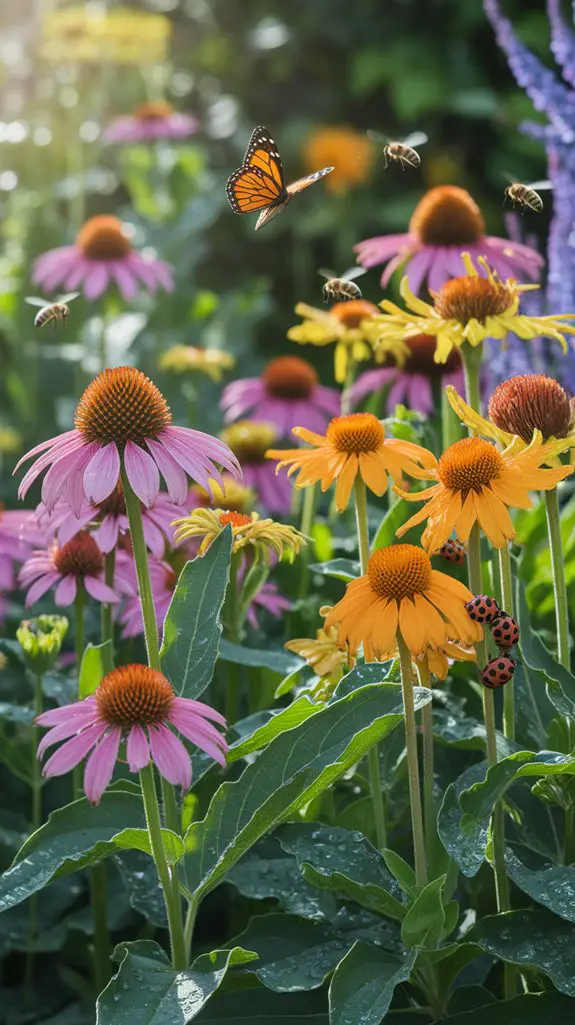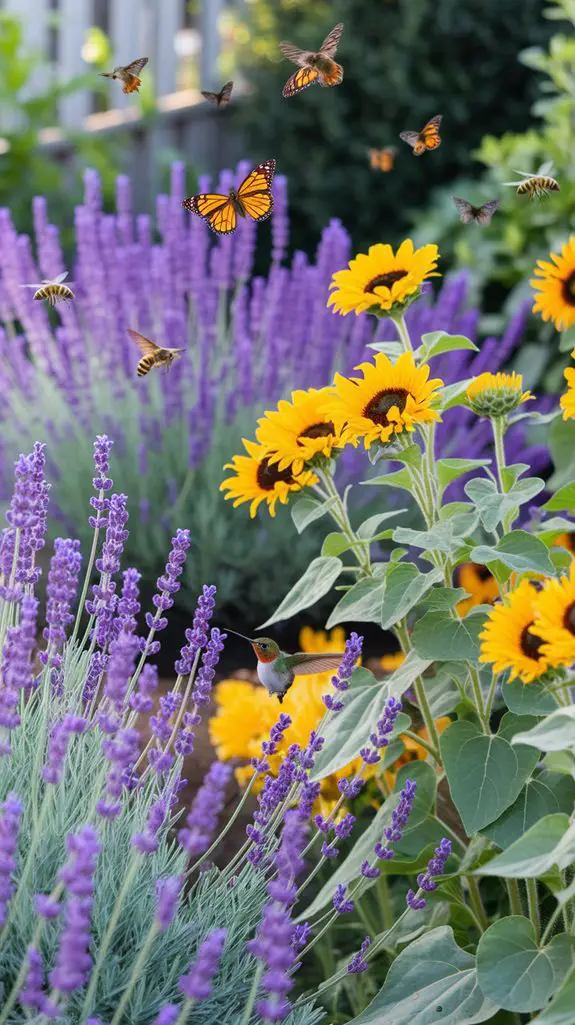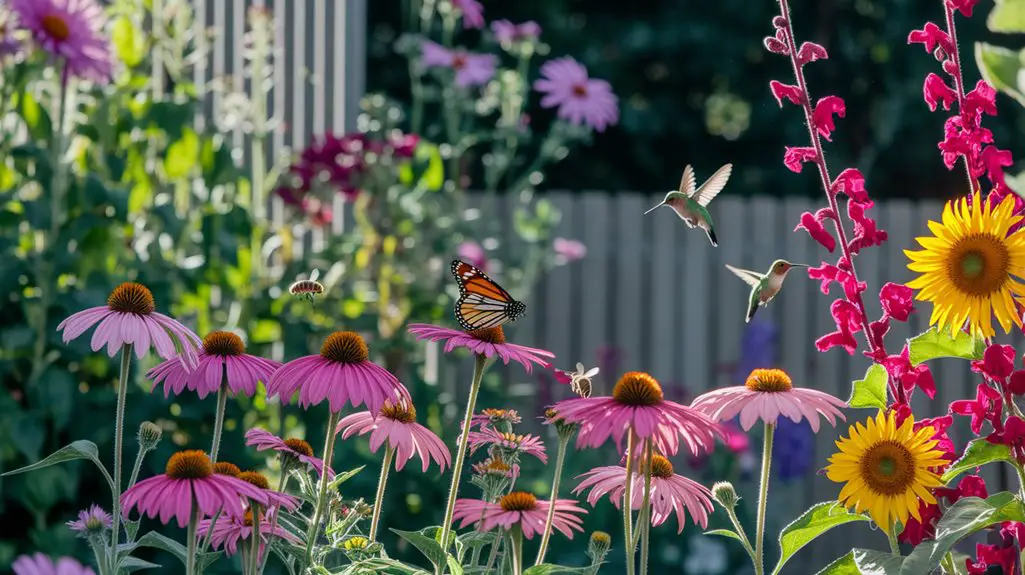When Emma transformed her neglected urban backyard into a pollinator paradise, her vegetable yields doubled within a single growing season. You’ll discover similar results by inviting these essential creatures into your garden space. Native flowering plants, strategic water features, and pesticide-free practices create an irresistible habitat for bees, butterflies, and other beneficial insects. The secret lies in understanding which specific elements attract different pollinators—and how to maintain their presence year-round.
The Vital Role of Pollinators in Vegetable Production
While many backyard gardeners focus primarily on soil quality and watering schedules, the presence of pollinators often determines whether your vegetable garden thrives or merely survives.
Nearly 75% of flowering plants depend on pollinators for reproduction, including most of your favorite vegetables.
Without these industrious creatures, you’ll see dramatic reductions in yields of tomatoes, peppers, squash, and cucumbers.
Squash and pumpkins require pollinators to transfer pollen between male and female flowers, while tomatoes benefit from buzz pollination that only certain bees provide.
Even self-pollinating plants produce more abundantly with pollinator assistance.
You’ll notice improved fruit size, shape, and seed development when bees, butterflies, and other beneficial insects regularly visit your garden beds.
Creating a pollinator-friendly garden can attract a diverse range of these essential insects, further enhancing your vegetable production.
Native Plants That Attract Beneficial Insects

Native plants form the foundation of any pollinator-friendly garden, having evolved alongside local insect species for thousands of years. These plants offer exactly what your local beneficial insects need: appropriate nectar, pollen, and habitat structures.
Consider adding coneflowers, which attract ladybugs that devour aphids. Black-eyed Susans provide food for predatory wasps that control caterpillar populations. Joe-Pye weed supports hoverflies—excellent pollinators whose larvae consume pest insects.
Don’t overlook native grasses and sedges; they serve as host plants for beneficial insects throughout their lifecycle. Plant milkweed for monarch butterflies, asters for native bees, and goldenrod for late-season nectar sources.
When you’re selecting plants, aim for continuous blooming from spring through fall to maintain a steady food supply for your garden allies. Integrating eco-friendly practices into your gardening approach can further enhance the benefits for pollinators.
Creating a Year-Round Pollinator Habitat

Although many gardeners focus on summer blooms, establishing a year-round pollinator habitat requires thoughtful planning for all seasons. You’ll need to select plants with staggered blooming periods and provide essential habitat elements throughout the year.
| Season | Key Plants | Habitat Features |
|---|---|---|
| Spring | Crocus, Bluebells, Serviceberry | Leave leaf litter for emerging bees |
| Summer | Echinacea, Milkweed, Lavender | Provide shallow water dishes |
| Fall/Winter | Aster, Goldenrod, Witch Hazel | Install insect hotels, leave seedheads |
Don’t forget to include sheltered areas where pollinators can overwinter. Hollow stems, rock piles, and undisturbed soil provide vital protection during cold months. By maintaining continuous bloom cycles and diverse structural elements, you’ll create a sanctuary that supports pollinator populations year-round. Additionally, creating a habitat for beneficial insects can further enhance the diversity and resilience of your garden ecosystem.
Water Sources and Shelter for Pollinator Friends
Just as flowers provide essential nectar and pollen, proper water sources and shelter are fundamental components of any pollinator-friendly garden.
Create shallow water features using bird baths with pebbles or wet sand where bees can safely land without drowning. Change the water every few days to prevent mosquito breeding.
For shelter, incorporate various natural materials. Leave some areas of bare soil for ground-nesting bees, and maintain small brush piles for overwintering insects.
Consider installing a bee hotel with different-sized hollow tubes for solitary bees, or plant dense shrubs where butterflies can hide from predators and harsh weather.
Don’t over-tidy your garden in fall—hollow stems and leaf litter provide vital winter habitat. Additionally, choosing native plants can enhance the habitat for local pollinators by providing food and shelter that they have evolved to utilize.
When you provide both food and shelter, you’ll create a complete sanctuary that supports pollinators throughout their life cycles.
Avoiding Pesticides and Chemical Deterrents
Protecting the sanctuary you’ve created for pollinators extends beyond providing food, water, and shelter—it requires vigilant management of what doesn’t belong in your garden. Chemical pesticides pose severe threats to bees, butterflies, and other beneficial insects, often killing them alongside targeted pests.
| Harmful Substances | Safe Alternatives |
|---|---|
| Neonicotinoids | Neem oil |
| Glyphosate | Horticultural soap |
| Pyrethroids | Companion planting |
| Organophosphates | Diatomaceous earth |
| Carbamates | Manual removal |
Embrace integrated pest management by introducing beneficial predators like ladybugs and lacewings. When intervention becomes necessary, opt for targeted organic solutions rather than broad-spectrum chemicals. Apply remedies during evening hours when pollinators are less active. Remember, a healthy ecosystem naturally balances itself—some plant damage indicates a thriving garden environment. Additionally, understanding organic pest control can help you make informed choices about maintaining your garden’s health.
Specialized Gardens: Butterfly, Bee, and Hummingbird Zones
While a diverse pollinator garden benefits many species, creating specialized zones tailored to specific pollinators maximizes your garden’s ecological impact.
Designate a sunny, sheltered area for butterflies with flat landing surfaces like coneflowers and zinnias, plus host plants such as milkweed for monarchs and parsley for swallowtails.
For bees, incorporate clumping natives that bloom sequentially throughout the growing season.
Think lavender, borage, and oregano, which provide abundant nectar access. Include bare soil patches for ground-nesting species.
Hummingbird zones should feature tubular flowers like cardinal flower, bee balm, and salvias.
Arrange these in tiered plantings, as hummers prefer to feed at multiple heights.
Add a clean water source—shallow for bees and butterflies, moving water for hummingbirds—to complete each specialized habitat. Additionally, including pollinator-friendly herbs can further enhance your garden’s appeal and support various species.
Companion Planting Strategies for Maximum Pollination
Companion planting, when strategically implemented in your pollinator garden, creates synergistic relationships that enhance both plant health and pollination rates.
Pair tall sunflowers with cucumber vines to provide natural climbing structures and attract diverse pollinators to both plants. Interplant sweet alyssum with strawberries to draw beneficial insects that pollinate berries while controlling pests.
You’ll maximize pollination by arranging plants in drifts rather than isolated specimens—bees prefer working multiple blooms of the same species before moving on.
Combine early, mid, and late-season bloomers in each garden section to maintain continuous pollinator presence.
Consider herb companions like dill and fennel, which support butterfly larvae while attracting adult pollinators with their delicate umbel flowers. Additionally, using native plants in your garden can significantly improve habitat quality for pollinators.
Conclusion
You’ll find that creating a pollinator paradise transforms your entire garden ecosystem. The Smithfield Community Garden in Iowa saw vegetable yields increase by 40% after establishing dedicated pollinator zones with coneflowers, bee balm, and native grasses. Your garden can achieve similar results. Remember: each butterfly that visits your zinnia patch represents dozens of future tomatoes and squash on your dinner table.




